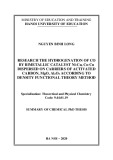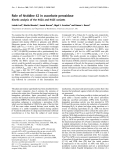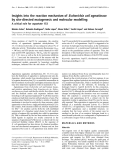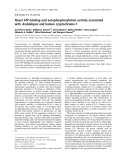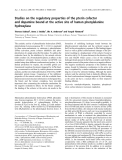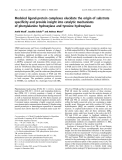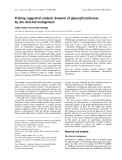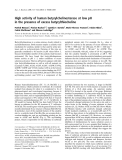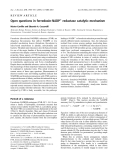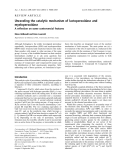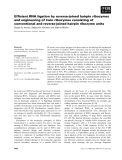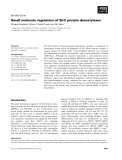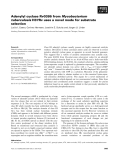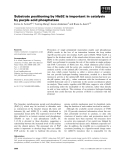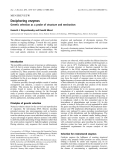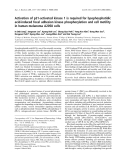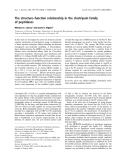
Catalytic mechanism
-
A reaction happens need the energy to vibrate the molecules and the reactant concentration enough. The energy here is often provided by heat. However, in living system, high temperature may harm the biological structure Truly that the concentration in living system is very low. So living organisms solve these problems by using enzyme
 94p
94p  zingzing09
zingzing09
 21-10-2012
21-10-2012
 68
68
 10
10
 Download
Download
-
Research purpose: Using computational chemistry methods to study the mechanism of hydrogenation CO on the transition metal catalyst systems of Ni, Cu, Co, bimetallic catalysts NiCu, CoCu and catalytic systems bearing cluster on oxide carriers: MgO, Al2O3 and activated carbon (AC); compare and clarify the role of catalyst centers in single or bimetallic catalyst systems; clarifies the role of carriers (MgO, Al2O3 and AC) in the hydrogenation of CO.
 27p
27p  thebadguys
thebadguys
 08-06-2021
08-06-2021
 29
29
 4
4
 Download
Download
-
Purpose: Using the density functional method (DFT) to find out the mechanism of CO2 hydrogenation reaction, the main product, by-products, the optimal reaction path, compare and evaluate the catalytic ability of the Ni5 cluster, Ni5/MgO, and Ni5/AC.
 25p
25p  thebadguys
thebadguys
 08-06-2021
08-06-2021
 13
13
 3
3
 Download
Download
-
To examine the role of the distal His42 residue in the catalytic mechanism of pea cytosolic ascorbate peroxidase, two site-directed variants were prepared in which His42 was replaced with alanine (H42A) or glutamic acid (H42E). Electronic spectra of the ferric derivatives of H42A and H42E (pH 7.0, l ¼ 0.10 M, 25.0 °C) revealed wavelength maxima [kmax (nm): 397, 509, % 540sh, 644 (H42A); 404, 516, % 538sh, 639 (H42E)] consistent with a predominantly fiveco-ordinate high-spin iron. The specific activity of H42E for oxidation of L-ascorbate (8.2 ± 0.
 11p
11p  system191
system191
 01-06-2013
01-06-2013
 41
41
 4
4
 Download
Download
-
Upon mutation of Asp153 by asparagine, the catalytic activity of agmatinase (agmatine ureohydrolase, EC 3.5.3.11)fromEscherichia coliwas reduced to about 5% of wild-type activity. Tryptophan emission fluorescence (kmax ¼340 nm), and CD spectra were nearly identical for wild-type and D153N agmatinases. TheKmvalue for agmatine (1.6 ± 0.1 mM),aswellastheKi for putrescine inhibition (12 ± 2 mM)and the interaction of the enzyme with the requiredmetal ion,werealsonot alteredbymutation.
 5p
5p  tumor12
tumor12
 22-04-2013
22-04-2013
 24
24
 3
3
 Download
Download
-
Metabolite channelling, the process in which consecutive enzymes have confined substrate transfer in metabolic pathways, has been proposed as a biochemical mechanism that has evolved because it enhances catalytic rates and protects unstable intermediates. Results from experiments on the synthesis of radioactive urea [Cheung, C., Cohen, N.S. & Raijman, L (1989)J. Biol. Chem.264, 4038–4044] have been interpreted as implying channelling of arginine between argininosuccinate lyase and arginase in permeabi-lized hepatocytes. ...
 9p
9p  tumor12
tumor12
 20-04-2013
20-04-2013
 35
35
 1
1
 Download
Download
-
Cryptochromes are blue-light photoreceptors sharing sequence similarity to photolyases, a class of flavoenzymes catalyzing repair ofUV-damagedDNAvia electron transfer mechanisms. Despite significant amino acid sequence simi-larity in both catalytic and cofactor-binding domains, cryptochromes lack DNA repair functions associated with photolyases, and the molecular mechanism involved in cryptochrome signaling remains obscure.
 8p
8p  tumor12
tumor12
 20-04-2013
20-04-2013
 38
38
 3
3
 Download
Download
-
The catalytic activity of phenylalanine hydroxylase (PAH, phenylalanine 4-monooxygenase EC 1.14.16.1) is regulated by three main mechanisms, i.e. substrate (L-phenylalanine, L-Phe) activation, pterin cofactor inhibition and phos-phorylation of a single serine (Ser16) residue.To address the molecular basis for the inhibition by the natural cofactor (6R)-L-erythro-5,6,7,8-tetrahydrobiopterin, its effects on the recombinant tetrameric human enzyme (wt-hPAH) was studied using three different conformational probes, i.e.
 10p
10p  tumor12
tumor12
 20-04-2013
20-04-2013
 37
37
 3
3
 Download
Download
-
NMR spectroscopy and X-ray crystallography have provi-ded important insight into structural features of phenyl-alanine hydroxylase (PAH) and tyrosine hydroxylase (TH). Nevertheless, significant problems such as the substrate specificity of PAHand the different susceptibility of TH to feedback inhibition by L-3,4-dihydroxyphenylalanine (L-DOPA) compared with dopamine (DA) remain unre-solved.
 11p
11p  tumor12
tumor12
 20-04-2013
20-04-2013
 55
55
 3
3
 Download
Download
-
The plant enzyme arbutin synthase isolated from cell sus-pension cultures ofRauvolfia serpentinaand heterologously expressed inEscherichia coliis a member of the NRD1b family of glycosyltransferases. This enzyme was used to prove, by site-directed mutagenesis, suggested catalytic domains and reaction mechanisms proposed for enzyme-catalyzed glycosylation. Replacement of amino acids far from the NRD domain do not significantly affect arbutin synthase activity.
 6p
6p  tumor12
tumor12
 20-04-2013
20-04-2013
 43
43
 3
3
 Download
Download
-
Butyrylcholinesterase is a serine esterase, closely related to acetylcholinesterase. Both enzymes employ a catalytic triad mechanism for catalysis, similar to that used by serine pro-teases such as a-chymotrypsin. Enzymes of this type are generally considered to be inactive at pH values below 5, because the histidine member of the catalytic triad becomes protonated. We have found that butyrylcholinesterase retains activity at pH £ 5, under conditions of excess substrate activation.
 10p
10p  tumor12
tumor12
 20-04-2013
20-04-2013
 26
26
 4
4
 Download
Download
-
Ferredoxin (flavodoxin)-NADP(H) reductases (FNR) are ubiquitous flavoenzymes that deliver NADPH or low potential one-electron donors (ferredoxin, flavodoxin) to redox-based metabolisms in plastids, mitochondria and bacteria. The plant-type reductase is also the basic prototype for one of the major families of flavin-containing electron transferases that display common functional and structural properties.
 16p
16p  fptmusic
fptmusic
 16-04-2013
16-04-2013
 44
44
 2
2
 Download
Download
-
Although belonging to the widely investigated peroxidase superfamily, lactoperoxidase (LPO) and myeloperoxidase (MPO) share structural and functional features that make them peculiar with respect to other enzymes of the same group. A survey of the available literature on their catalytic intermediates enabled us to ask some questions that remained unanswered. These questions concern controver-sial features of theLPOandMPOcatalytic cycle, suchas the existence of Compound I and Compound II isomers and the identification of their spectroscopic properties....
 10p
10p  fptmusic
fptmusic
 12-04-2013
12-04-2013
 39
39
 2
2
 Download
Download
-
In recent years major progress has been made in elucidating the mechanism and structure of catalytic RNA molecules, and we are now beginning to understand ribozymes well enough to turn them into useful tools. Work in our laboratory has focused on the development of twin ribozymes for site-specific RNA sequence alteration. To this end, we followed a strategy that relies on the combination of two ribozyme units into one molecule (hence dubbed twin ribozyme).
 11p
11p  fptmusic
fptmusic
 11-04-2013
11-04-2013
 44
44
 2
2
 Download
Download
-
The Sir2 family of histone⁄protein deacetylases (sirtuins) is comprised of homologues found across all kingdoms of life. These enzymes catalyse a unique reaction in which NAD + and acetylated substrate are converted into deacetylated product, nicotinamide, and a novel metabolite O-acetyl ADP-ribose. Although the catalytic mechanism is well conserved across Sir2 family members, sirtuins display differential specificity toward acetyl-ated substrates, which translates into an expanding range of physiological functions. ...
 10p
10p  fptmusic
fptmusic
 11-04-2013
11-04-2013
 49
49
 3
3
 Download
Download
-
Class III adenylyl cyclases usually possess six highly conserved catalytic residues. Deviations in these canonical amino acids are observed in several putative adenylyl cyclase genes as apparent in several bacterial genomes. This suggests that a variety of catalytic mechanisms may actually exist. The geneRv0386from Mycobacterium tuberculosiscodes for an adenylyl cyclase catalytic domain fused to an AAA-ATPase and a helix-turn-helix DNA-binding domain.
 8p
8p  fptmusic
fptmusic
 11-04-2013
11-04-2013
 29
29
 3
3
 Download
Download
-
Proteolysis of single polypeptide mammalian purple acid phosphatases (PAPs) results in the loss of an interaction between the loop residue Asp146 and the active site residues Asn91 and⁄or His92. While Asn91 is a ligand to the divalent metal of the mixed-valent di-iron center, the role of His92 in the catalytic mechanism is unknown. Site-directed mutagenesis of His92 was performed to examine the role of this residue in single polypep-tide PAP.
 10p
10p  awards
awards
 06-04-2013
06-04-2013
 44
44
 3
3
 Download
Download
-
The efficient engineering of enzymes with novel activities remains an ongoing challenge. Towards this end, genetic selection techniques provide a method for finding rare solutions to catalytic problems that requires only a limited foreknowledge of structure–function relationships. We have used genetic selections to extensively probe the structure and mechanism of chorismate mutases. The insights gained from these investigations will aid future enzyme design efforts.
 8p
8p  dell39
dell39
 03-04-2013
03-04-2013
 52
52
 4
4
 Download
Download
-
Lysophosphatidicacid (LPA), oneof thenaturallyoccurring phospholipids, stimulates cellmotility through theactivation of Rho family members, but the signaling mechanisms remain tobe elucidated. In thepresent study,we investigated the roles of p21-activated kinase 1 (PAK1) onLPA-induced focal adhesion kinase (FAK) phosphorylation and cell motility.
 9p
9p  dell39
dell39
 03-04-2013
03-04-2013
 36
36
 3
3
 Download
Download
-
In this study we investigate the active-site structure and the catalytic mechanism of clostripain by using a combination of three separate techniques: affinity labelling, site-directed mutagenesis and molecular modelling. A benzamidinyl-diazo dichlorotriazine dye (BDD) was shown to act as an efficient active site-directed affinity label for Clostridium histolyticumclostripain. The enzyme, upon incubation with BDD in 0.1MHepes/NaOHbuffer pH 7.6, exhibits a time-dependent loss of activity.
 10p
10p  dell39
dell39
 03-04-2013
03-04-2013
 55
55
 3
3
 Download
Download
CHỦ ĐỀ BẠN MUỐN TÌM










